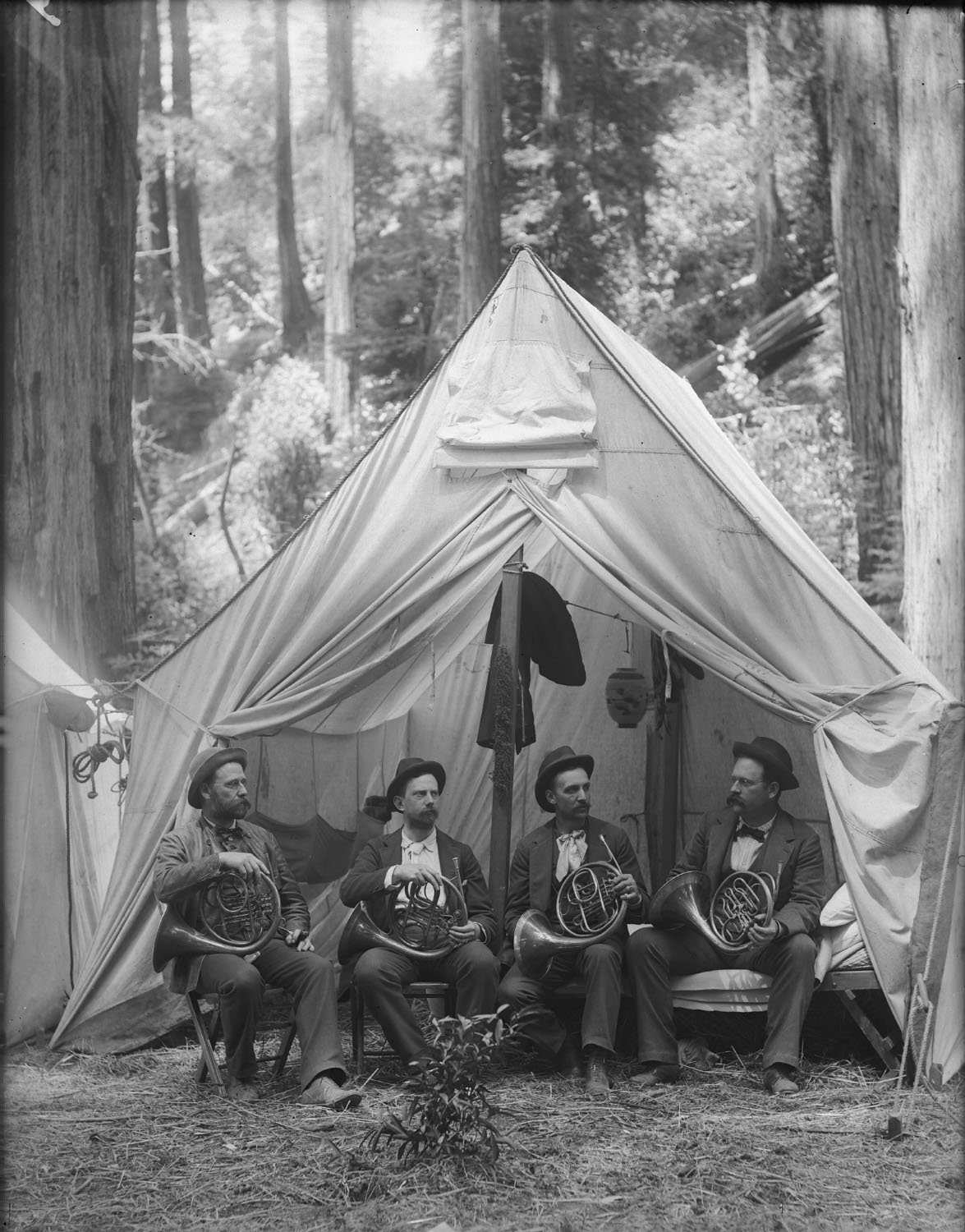
|
|
| The Bohemian Club is a prominent private club in San Francisco, California. It was founded in 1872 originally exclusively by and for journalists, who lamented the lack of art and culture in post-gold rush San Francisco and wanted to capture something of la vie boh&egrav;me which had become popularized among the avant garde of the United States at the time. The group quickly relaxed its rules for membership to permit some people to join who had no artistic talent, but had major financial resources. Pretty soon, the "bohemian" writers were in the minority and the wealthy and powerful controlled the club - something which remains true today. Soon after its founding the club was holding annual camping retreats in its own Bohemian Grove in Monte Rio, California. By the 1890s, when the above photo was taken, the annual outings included theatrical musical productions with an orchestra comprising club members including this horn quartet. The members of the quartet have been identified as N. Clifford Page (1866 - 1956), George A. Story, George W. Fletcher, and George H. Strong. | |
Composer, arranger, and hornist Nathaniel Clifford Page
was born October 26, 1866 in San Francisco. He was the son of merchant Nathan
(1809 - 18??) and Amelia Page (1827 - 18??). Publishing under the name of N. Clifford Page
he is best known as a prolific arranger of
popular melodies and light classical pieces for small orchestras and bands.
Some of his many arrangements include:
Page also composed the song "Three Little Chestnuts" (1897). His larger
compositions include the
operas Japanese Nightningale; The First Lieutennant; the suite for
orchestra Pageant for the Pilgrims Tercentenary; the choral cycle
Old Plantation Days; and the choral ballad Lord Howes Masquerade. Page
was a music editor for Ditson and Carl Fischer, Inc. and lectured on orchestration
at Columbia University. In 1928 he and Arthur Edward Johnstone published a book titled
Instruments of the Modern Symphony Orchestra and Band.
|
George A. Story was a member of the board of
directors and treasurer of the Bohemian Club. He was a member of Merten, Moffitt & Co. (1889),
manufacturing chemists and teller (1890) and cashier(1910) of the Mutual Savings Bank of San Francisco.
On January 1, 1889 Mr. Story and fellow horn play, George H. Strong (see below) took part
in the Pacific Coast Amateur Photographic Association's expedition to Cloverdale, Sonoma County,
California to observe, photograph, and record the total eclipse of the sun. The expedition
was led by astronomer Charles Burkholder from the Chabot Observatory, Oakland, California.
Neither Story nor Strong was a member of the Association, however.
Mr. Strong was brought along as an assistant to Mr. Burkholder. On the day of the total
eclipse, one of his tasks was to count seconds out loud to assist the photographers with
timing the exposures with their various cameras. Mr. Story was assigned to Mr.
James H. Johnson, secretary of the P.C.A.P.A. as a "recorder" with the task of noting the exact moment during
the eclipse that the photographic plate was exposed and the duration of the exposure based upon Mr. Strong's count.
Mr. Johnson commented in his report: "To Mr. Geo. A Story, who kindly recorded my exposure
I feel particularly grateful, giving up as he did, time which he might have devoted to
admiring the eclipse. His kindness is the more conspicuous, as he was a stranger to me."
In 1908-9 Mr. Story served on the Associated Savings Banks subcommittee under the Citizens' Health Committee for Eradicating Plague from San Francisco |
|
|
George William Fletcher (ca. 1853 - 19??) was born in New York.
His father was from Connecticut and his mother was born in England. By 1880 he and his wife, A. M.
Fletcher (ca. 1855, Ireland, - ?), had moved to San Francisco where he was the commercial and freight agent and for the Southern
Pacific Railroad as well as manager of the Mission Bay warehouse. He lived at various addresses in
downtown San Francisco but moved to Berkeley after the 1906 earthquake. Politically he was a Republican.
|
George Henry Strong (1839-19??) was born at Northampton, Massachusetts. He was a descendant of the early Pilgrims, tracing his ancestry back to John Strong who had landed in Massachusetts in 1630. After graduating from Dartmouth College he moved to San Francisco where he became patent solicitor and attorney. He was also connected with the firm of Dewey & Co., publishers of the Scientific Press and a member of the Astronomical Society of the Pacific (see above). An avid sportsman, he was for many years a on the directorate of the Olympic Club, the Pioneer Rowing Club, the San Francisco and Oakland Bicycle Club, and the Alameda Automobile Club. In 1879 at the age of forty he ascended Half Dome in Yosemite National Park with George Anderson. He was a co-author of a biking book, The Cyclists' Road-book of California: Containing Maps of the Principal Riding Districts North, East and South from San Francisco, published in 1893. In his later years, he lived in Oakland, with the family of his daughter Georgie Strong Hubbard. George Strong died some time after 1927. |